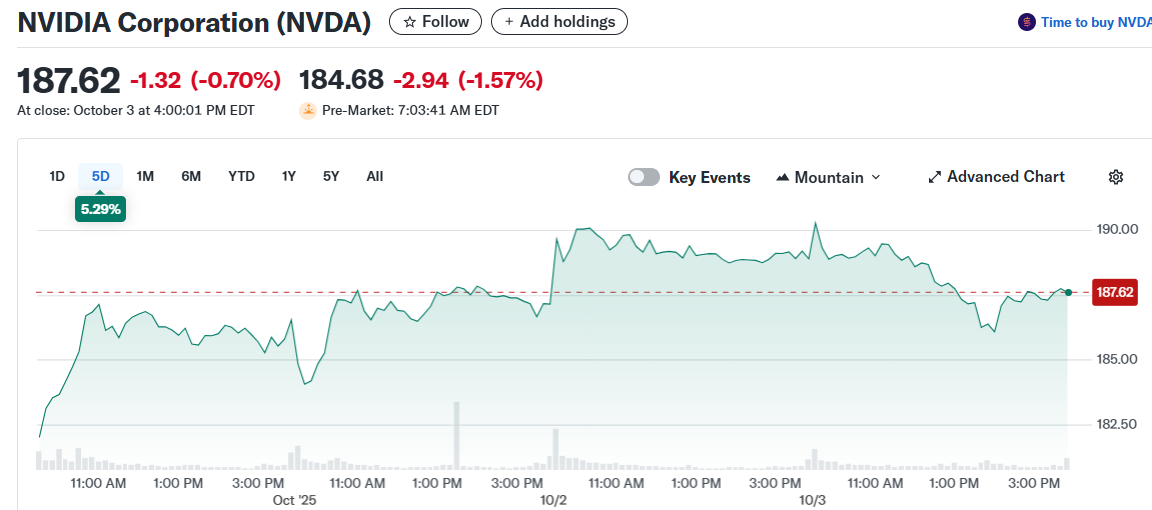TLDR
- Goldman Sachs increased Nvidia price target from $200 to $210 while maintaining Buy rating on the stock
- The upgrade reflects growing AI partnerships including OpenAI collaboration and expanding data center infrastructure projects
- Analyst warns that Nvidia’s investments in customers like OpenAI create “circular revenue” where the company’s own capital funds GPU purchases
- OpenAI infrastructure spending could reach $75 billion in 2026 with heavy reliance on Nvidia chips
- Wall Street analysts remain bullish with Strong Buy rating and $216.50 average price target showing 15.39% upside
Goldman Sachs analyst James Schneider lifted his Nvidia price target to $210 from $200 this week. He maintained a Buy rating on the chipmaker.
The new target implies roughly 12% upside from current levels. Nvidia traded at $187.62, close to its 52-week high of $191.05.

The upgrade centers on Nvidia’s expanding AI partnerships. Strategic investments and deals with OpenAI and other companies are driving the bullish outlook.
Schneider believes these partnerships will generate fresh GPU demand. They also strengthen Nvidia’s dominance in AI infrastructure.
OpenAI Infrastructure Push
OpenAI’s spending needs are exploding. Goldman estimates the company may require up to $75 billion in 2026.
This money will fund self-built data centers packed with Nvidia GPUs. The Stargate project and other initiatives also need financing.
Oracle recently raised $18 billion in debt specifically to support OpenAI infrastructure. Goldman says this project shows strong market momentum.
These facilities will depend heavily on Nvidia hardware. Schneider sees a clear runway for continued chip sales.
OpenAI will lean on equity and debt financing for expansion. This external funding could drive legitimate customer demand.
The Circular Revenue Problem
Schneider raised red flags about deal structures. He warns Nvidia’s investments in companies like OpenAI create “circular revenue.”
This occurs when Nvidia invests in a company that uses those funds to buy Nvidia chips. Sales appear on the books but are funded by Nvidia’s own money.
The analyst says this dual investor-supplier role demands closer examination. It could make some revenue less valuable than traditional sales.
Circular revenue might inflate short-term numbers. But it makes long-term growth harder to predict.
Schneider urges investors to track how much demand stems from outside funding versus Nvidia’s investments. This matters for stock valuation.
Goldman notes circular revenue could pressure Nvidia’s valuation multiple. The stock currently trades at a P/E ratio of 53.36.
The analyst still views partnerships positively overall. But he wants transparency around revenue quality.
Wall Street Consensus
Analysts remain overwhelmingly bullish on Nvidia. The stock carries a Strong Buy rating based on 36 Buy calls, two Holds, and one Sell.
The average Wall Street price target sits at $216.50. This implies 15.39% upside potential.
Goldman’s $210 target falls slightly below the consensus. The firm keeps its Buy rating despite circular revenue concerns.
Nvidia partnerships keep expanding. Microsoft recently struck a $19.4 billion deal with Nebius Group for over 100,000 Nvidia chips.
Cantor Fitzgerald holds a $240 price target. The firm calls the OpenAI investment strategically smart for infrastructure positioning.
Goldman Sachs set a $210 price target on Monday, citing AI tailwinds while cautioning about revenue circularity risks from customer investments.


